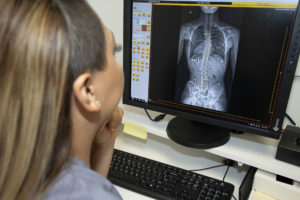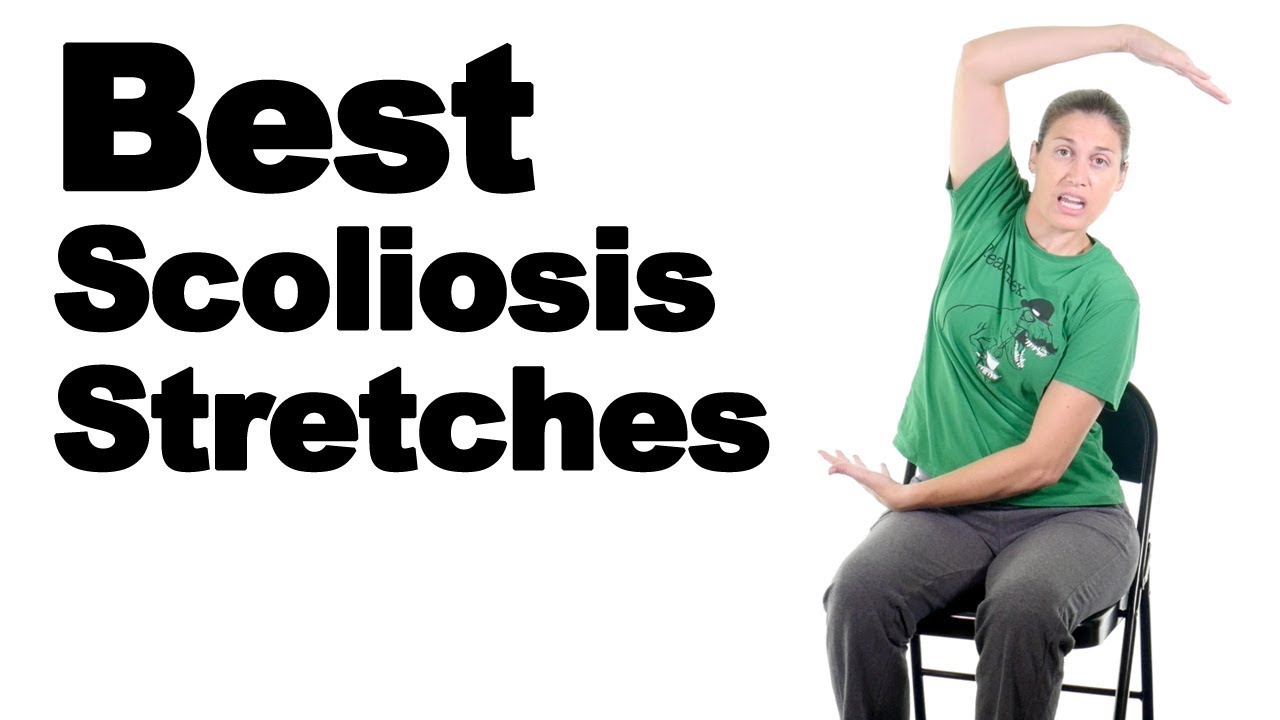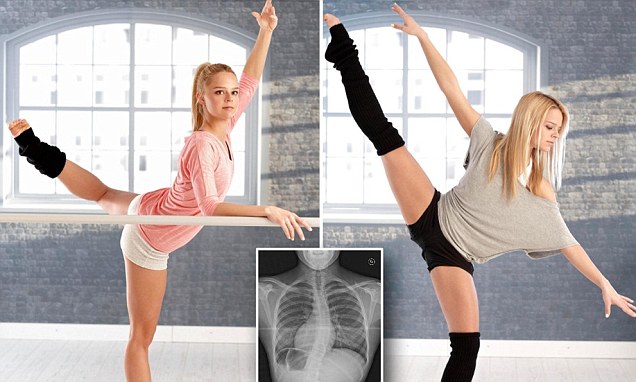脊柱側湾症はダンサーのテクニックに大きな影響を与えます。背骨の異常な湾曲は身体のアライメントに影響を与え、正しい姿勢とバランスを保つことを難しくします。その結果、動きが左右非対称になったり、可動域が制限されたりします。脊柱側湾症のダンサーは、アラベスクやバックベンドなど、背骨をまっすぐにする必要がある特定の動きに苦労することがあります。

ダンサーの脊柱側湾症の兆候と症状の認識
側湾症の兆候や症状を認識することは、ダンサー、教師、両親にとって非常に重要です。例えば、不揃いな肩、突出した肩甲骨、不揃いなウエストライン、目立つ背骨のカーブなどです。ダンサーはまた、背中の痛み、筋肉のアンバランス、疲労を経験することもあります。定期的に観察し、意識することで、脊柱側湾症を早期に発見することができ、タイムリーな介入が可能になります。
脊柱側湾症の診断専門家の助けを求める
側湾症が疑われる場合は、正確な診断のために専門家の助けを借りることが不可欠です。ダンスの先生や親は、整形外科の専門医や理学療法士など、側湾症を専門とする医療専門家にダンサーを紹介することができます。医療専門家は、身体的評価、X線検査、その他の診断検査を含む徹底的な検査を行い、症状の重症度と進行度を判断します。

側湾症ダンサーのための治療法
側湾症のダンサーの治療法は、湾曲の度合いや個々のニーズによって異なります。軽度の場合は、定期的なモニタリングとエクササイズで十分対処できるかもしれません。重度の場合は、装具や手術が勧められることもあります。装具療法では、湾曲を矯正し、さらなる進行を防ぐために、専用の装具を装着します。一方、手術は、湾曲が急速に進行したり、著しい痛みや機能的制限を引き起こしたりしている重症の場合に考慮されます。
スコリオティック・ダンサーのための筋力強化とストレッチ・エクササイズ
ダンサーの脊柱側弯症の管理には、筋力強化とストレッチのエクササイズが重要な役割を果たします。これらのエクササイズは、体幹の強さ、柔軟性、体全体のアライメントを改善することを目的としています。ピラティス、ヨガ、筋力トレーニングなどの特定のエクササイズは、背骨を囲む筋肉を強化し、より良い姿勢を促進するのに役立ちます。ストレッチ・エクササイズは、柔軟性を向上させ、脊柱側湾症による筋肉のアンバランスを緩和するのに役立ちます。

姿勢とアライメント:脊柱側弯症のダンサーのための主な考慮事項
姿勢とアライメントはダンステクニックの基本であり、脊柱側湾症のダンサーはこれらの部分に特に注意を払う必要があります。正しい姿勢とアライメントは、脊柱側湾症がダンスの動きに与える影響を最小限に抑えるのに役立ちます。ダンス教師と理学療法士は、ダンストレーニング中に正しいアライメントと姿勢を維持するための指導を行うことができます。これには、特定の合図、エクササイズ、またはダンサー特有の脊柱の湾曲に対応するための修正が含まれる場合があります。
スコリオティックのダンサーに適したダンススタイルを見つける
脊柱側弯症は困難な問題ではありますが、脊柱側弯症のダンサーが自分の選んだダンススタイルで活躍できないということではありません。脊柱側湾症のダンサーにとって重要なのは、自分の体に合った、自分の長所を発揮できるダンススタイルを見つけることです。コンテンポラリーやリリカルなど、流れるような表現に重点を置いているため、脊柱側弯症のダンサーにも寛容なダンススタイルもあります。しかし、適切なトレーニングとサポートがあれば、脊柱側弯症のダンサーはどんなダンススタイルでも優れたパフォーマンスを発揮することができます。
脊柱側弯症のダンサーをサポートする道具と設備
脊柱側弯症のダンサーのトレーニングやパフォーマンスをサポートする様々な道具や器具があります。これらには、背骨をさらにサポートし安定させるダンス専用のベルトや装具、装具などがあります。ダンスの先生や医療専門家は、ダンサーの安全性と快適性を確保するために、これらの道具の適切な使い方を推奨し、指導することができます。
側湾症ダンサーの心理的・精神的サポート
脊柱側湾症と共に生きることは、ダンサーの心理的、感情的な幸福に大きな影響を与える可能性があります。脊柱側湾症のダンサーが直面する可能性のある問題に対処するために、必要なサポートやリソースを提供することが不可欠です。そのためには、カウンセリング、サポートグループ、脊柱側湾症を克服した他のダンサーとの交流などが必要です。強力なサポートネットワークを構築することは、脊柱側湾症のダンサーが自信と回復力を持って歩んでいくのに役立ちます。
サクセスストーリー脊柱側湾症のダンサーを鼓舞する
脊柱側湾症を患ったダンサーたちが、その困難を克服し、キャリアにおいて目覚ましい成功を収めたサクセスストーリーは数多くある。その一例が、脊柱側湾症でありながらモダンダンスに革命を起こした、有名なアメリカのダンサーであり振付師であるマーサ・グラハムです。彼女の決意、才能、動きへの革新的なアプローチは、世界中の脊柱側湾症のダンサーにインスピレーションを与え続けている。これらのサクセスストーリーは、脊柱側湾症がダンサーの可能性を決めるものではないこと、そして献身と忍耐があれば何でも可能であることを思い出させてくれます。
結論挑戦を受け入れ、芸術性を称える
脊柱側湾症のダンサーは、ダンスとパフォーマンスを追求する上で独特の困難に直面します。しかし、適切な管理、サポート、そして前向きな考え方があれば、彼らはその技術で成功し、卓越し続けることができます。脊柱側湾症がダンステクニックに与える影響を理解し、兆候や症状を認識し、専門家の助けを求め、様々な治療法を模索することで、脊柱側湾症のダンサーは効果的に症状を管理することができます。姿勢とアライメントに焦点を当て、筋力強化とストレッチのエクササイズを行うことで、ダンスの能力をさらに高めることができます。適切なダンススタイルを見つけること、サポートツールや器具を活用すること、心理的・精神的なサポートを受けることも、彼らの旅には欠かせない要素です。困難を受け入れ、その芸術性を称えることで、脊柱側湾症のダンサーは他の人々にインスピレーションを与え、ダンスへの情熱に限界はないことを証明することができる。
参考文献
- [1] 米国側湾症財団.脊柱側湾症を理解する.にて入手可能: https://www.scoliosis.org/what-is-scoliosis
- [2] 脊柱側湾症研究会.側湾症とダンス」.にて入手可能: https://www.srs.org/professionals/patient-care/scoliosis-and-dance
- [3] メイヨークリニック。側湾症」。Available at: https://www.mayoclinic.org/diseases-conditions/scoliosis/diagnosis-treatment/drc-20373691
- [4] 米国整形外科学会。側弯症」。Available at: https://orthoinfo.aaos.org/en/diseases–conditions/scoliosis/
- [5] 国立関節炎・筋骨格系・皮膚疾患研究所。脊柱側湾症」。で入手可能: https://www.niams.nih.gov/health-topics/scoliosis
- [6] ダンスマガジン脊柱側湾症の管理:ダンサーのためのヒントにて入手可能: https://www.dancemagazine.com/managing-scoliosis-tips-dancers
- [7] Spine-Health.脊柱側湾症の治療と管理」。Available at: https://www.spine-health.com/conditions/scoliosis/scoliosis-treatment-and-management
- [8] 国際側弯症研究センター。「装具と手術の選択肢」.Available at: https://www.scoliosis-research.org/treatment-options
- [9] いつでもピラティス。側湾症のためのピラティス・エクササイズ'.にて入手可能: https://www.pilatesanytime.com/blog/pilates-exercises-scoliosis
- [10] ヨガジャーナル。側湾症のためのヨガ」.で入手可能: https://www.yogajournal.com/pose/yoga-for-scoliosis
- [11] 国立希少疾患機構.脊柱側湾症サポートリソース'.Available at: https://rarediseases.org/rare-diseases/scoliosis/resources
- [12] 脊柱側湾症研究会.側湾症を持つダンサーのサクセスストーリー'.Available at: https://www.srs.org/patients-and-families/scoliosis-success-stories
- [13] ダンス愛好家。脊柱側湾症に適したダンススタイルを見つける」.にて入手可能: https://www.dance-enthusiast.com/features/finding-right-dance-style-scoliosis
- [14] ダンスマガジン脊柱側湾症のダンサーのためのサポートツール』。で入手可能: https://www.dancemagazine.com/supportive-tools-dancers-scoliosis
- [15] 国立精神衛生研究所。ストレスと感情の健康の管理」。で入手可能: https://www.nimh.nih.gov/health/topics/managing-stress-and-emotional-health

